英汉翻译笔记整理
- 格式:doc
- 大小:39.00 KB
- 文档页数:12
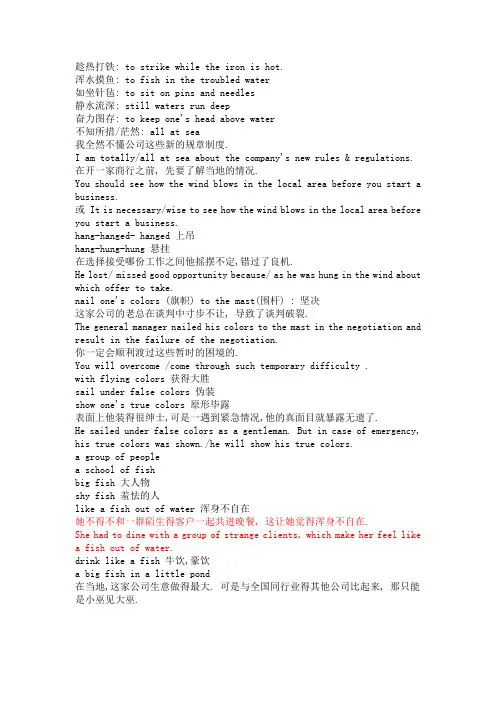
趁热打铁: to strike while the iron is hot.浑水摸鱼: to fish in the troubled water如坐针毡: to sit on pins and needles静水流深: still waters run deep奋力图存: to keep one's head above water不知所措/茫然: all at sea我全然不懂公司这些新的规章制度.I am totally/all at sea about the company's new rules & regulations. 在开一家商行之前, 先要了解当地的情况.You should see how the wind blows in the local area before you start a business.或 It is necessary/wise to see how the wind blows in the local area before you start a business.hang-hanged- hanged 上吊hang-hung-hung 悬挂在选择接受哪份工作之间他摇摆不定,错过了良机.He lost/ missed good opportunity because/ as he was hung in the wind about which offer to take.nail one's colors (旗帜) to the mast(围杆) : 坚决这家公司的老总在谈判中寸步不让, 导致了谈判破裂.The general manager nailed his colors to the mast in the negotiation and result in the failure of the negotiation.你一定会顺利渡过这些暂时的困境的.You will overcome /come through such temporary difficulty .with flying colors 获得大胜sail under false colors 伪装show one's true colors 原形毕露表面上他装得很绅士,可是一遇到紧急情况,他的真面目就暴露无遗了.He sailed under false colors as a gentleman. But in case of emergency, his true colors was shown./he will show his true colors.a group of peoplea school of fishbig fish 大人物shy fish 羞怯的人like a fish out of water 浑身不自在她不得不和一群陌生得客户一起共进晚餐, 这让她觉得浑身不自在.She had to dine with a group of strange clients, which make her feel like a fish out of water.drink like a fish 牛饮,豪饮a big fish in a little pond在当地,这家公司生意做得最大. 可是与全国同行业得其他公司比起来, 那只能是小巫见大巫.In the local area, the company has a wide business relationships.But compared with other companies in the same industry/field nationwide, it was only a big fish in a little pond.the great fish eat up the small这家公司设备陈旧,技术落后,在市场竞争中很快就被兼并了.The company was eaten up by great fish in the fierce market competition because it was lag behind both in equipment and technology.或With the outdated equipment and technology, the company was eaten by great fish in the competition.雨后春笋: bamboo shoots/like mushrooms after the rain掩耳盗铃: to bury one's head in the sand一箭双雕: to kill two birds with one stone健壮如牛: as strong as a horse一贫如洗: as pour as a church mouselucky dog :幸运儿love me, love my dog: 爱屋及乌狗仗人势: be a bully with the backing of a powerful person.狼心狗肺: ungrateful and heartless瓜熟蒂落: everything comes right when the right time comes瑞雪兆丰年: A timely snow promises a good harvestteach fish to swim: 班门弄斧black sheep: 害群之马,败家子The company lost a big order due to his carelessness. Most of the staffempolyees/colleages thought him as a black sheep, soon he took the blame and resigned.他的大意使得公司失去了一笔大订单. 大多数员工都把他当成是害群之马,不久他就引咎辞职了.come rain or shine: 不见不散不管什么情况下, 他都是一个可以值得信赖得朋友.Rain or shine, he is always a reliable/trustworthly friend.It never rains but pours. 不鸣则已,一鸣惊人for a rainy day 未雨绸缪in a fogHis mind was in a fog for a whole day.整整一天, 他的头脑都昏昏沉沉的.have the foggiest idea of他表达能力太差, 雇员们听了半天还是完全不知所云.He could not express himself clearly, and all the employees have the foggiest idea about what he talks about.空中楼阁: castles in the air自食其果: eat the fruit of one's own doing火上浇油: to pour oil on the flame轻如鸿毛: as light as a featherbird of a feather flock together :物以类聚胸有成竹: to have a well-thought-out plan before doing sth.剖腹藏珠: penny wise and pound foolish一朝被蛇咬,十年怕井绳: Once bitten, twice shy.无风不起浪: where there's smoke, there is fire.有志者事竟成: where there's a will, there is a way.新官上任三把火: A new broom (扫把) sweeps clean开门见山: to come straight to the point单枪匹马: to be single-handed in doing sth扬眉吐气: to feel proud and elated风雨飘摇: (of a situation ) being unstable初生牛犊不怕虎: The more wit, the less courage.叶公好龙: professed love of what one really fears.三个臭皮匠顶个诸葛亮: Two heads are better than one.赛翁失马,焉知非福: A loss may turn out to be a gain.初出茅庐: at the beginning of one's career.并驾齐驱: neck and neck不可一世: as proud as a peacock本末倒置: put the cart before the horse隔墙有耳: walls have ears入乡随俗: do in Rome as the Romans do画蛇添足: to paint the lilyRed-letter day(纪念日,喜庆的日子)如圣诞节等,因为这些日子在日历上是用红色标志出来的Roll out the red carpet for sb: 表示盛情欢迎某人Red for danger: 与流血,危险与暴力联系在一起红糖: blown sugar红茶: black tea红榜: honor roll红豆: love pea红运:good luck红利: dividend红颜: a beautiful girlRed ruin: 火灾Red battle: 血战Red sky: 彩霞Red tape: 繁文缛节Green: 表示嫉妒,眼红Green with envy/green as jealousy/green-eyed(红眼病)艾丽斯的女友看到他的新装, 心生嫉妒.Alice's girl friend was green with envy when they saw her new dress. Green:在英文中表示钱财,钞票,有经济实力;还表示没经验,缺乏训练,知识浅薄You cannot expect Mary to do business with such people.戴绿帽子: to be a cuckoldGreen:病态,脸色发青He was green after his boat ship. 他乘船回来,脸色发青。

(完整版)翻译笔记第一次课好英文:主次分明,逻辑严密,主三次八(主则主句主谓主系表,次则从句名形介副非谓三各种短语)好中文:音调和谐,结构匀称,具体表现凡十:双声(声母相同eg 坎坷,迷茫),叠韵(韵母相同eg 彷徨,徜徉),叠音,双音节,四字格,对仗,平仄,量词准(找准比喻角度,活用动量词eg.一本芭蕉),动词活(eg.眉毛一扬,头发一甩general/specific words)活用动词四法:具体,高频,靠近,连用好译文:faithful and smooth 忠通脱读是文章对读没走样(content &style)翻译:技巧,语言比较,相关表达怎么学:reading-observing-imitating-producing (speaking & writing & translating)条件:三语让之间之外技巧全攻略:增减逆顺转类换正反拆合引申难增减-eg.汉译英代词增加逆顺-英文先主后客,中文先客后主拆合-英译汉多拆;汉译英多合引申-深宽抽象事物具体化1.风在吼,马在叫,黄河在咆哮,河东河西高粱熟,万山丛中游击健儿逞英豪。
Wind howling,horses neighing,the Yellow River roaring. Sorghum ripe on both banks, the guerilla soldiers are fighting bravely in mountains beyond mountains.2.广出猎,见草中石以为虎而射之,中石,没全族,视之,石也,因复更射之,终不能入矣。
(三个左右的动词合一次,取一个最重要的做谓语)Once out on a hunting trip, General Li Guang mistook a rock in the grass for a tiger and shoot an arrow at it. He hit it with such force that the tip of the arrow get inside the rock. Laterhe discovered it to be only a rock. Thus, he wanted to try shooting again but was unable to pierce it.3.松下问童子,言师采药去。
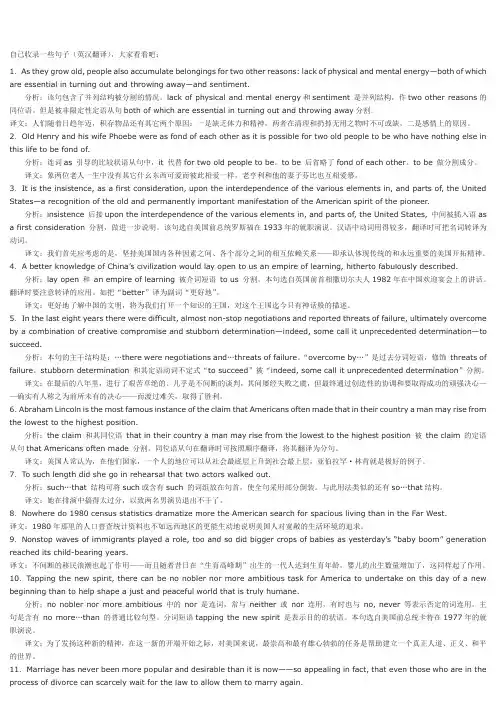
自己收录一些句子(英汉翻译),大家看看吧:1.As they grow old, people also accumulate belongings for two other reasons: lack of physical and m ental energy—both of which are essential in turning out and throwing away—and sentiment.分析:该句包含了并列结构被分割的情况。
lack of physical and mental energy和sentiment 是并列结构,作two other reasons的同位语。
但是被非限定性定语从句both of which are essential in turning out and throwing away分割。
译文:人们随着日趋年迈,积存物品还有其它两个原因:一是缺乏体力和精神,两者在清理和扔掉无用之物时不可或缺,二是感情上的原因。
2.Old Henry and his wife Phoebe were as fond of each other as it is possible for two old people to be who have nothing else in this life to be fond of.分析:连词as 引导的比较状语从句中,it 代替for two old people to be。
to be 后省略了fond of each other。
to be 做分割成分。
译文:象两位老人一生中没有其它什幺东西可爱而彼此相爱一样,老亨利和他的妻子芬比也互相爱慕。
3.It is the insistence, as a first consideration, upon the interdependence of the various elements in, and parts of, the United States—a recognition of the old and permanently important manifestation of the American spirit of the pioneer.分析:insistence 后接upon the interdependence of the various elements in, and parts of, the United States, 中间被插入语as a first consideration 分割,做进一步说明。
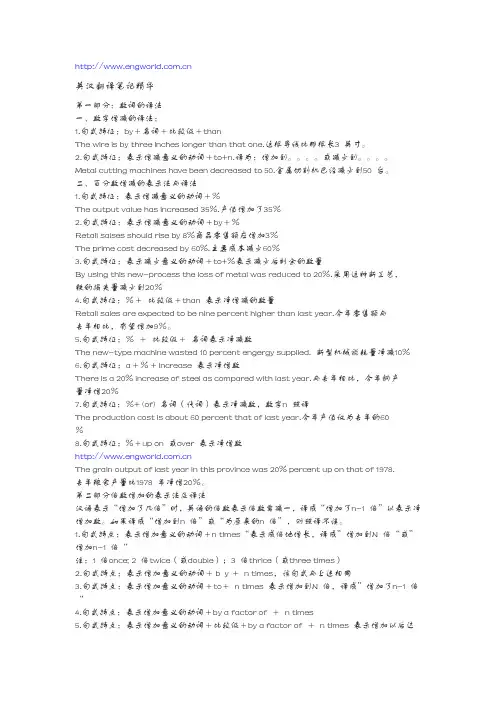
英汉翻译笔记精华第一部分:数词的译法一、数字增减的译法:1.句式特征:by+名词+比较级+thanThe wire is by three inches longer than that one.这根导线比那根长3 英寸。
2.句式特征:表示增减意义的动词+to+n.译为:增加到。
或减少到。
Metal cutting machines have been decreased to 50.金属切割机已经减少到50 台。
事、百分数增减的表示法与译法1.句式特征:表示增减意义的动词+%The output value has increased 35%.产值增加了35%2.句式特征:表示增减意义的动词+by+%Retail salses should rise by 8%商品零售额应增加3%The prime cost decreased by 60%.主要成本减少60%3.句式特征:表示减少意义的动词+to+%表示减少后剩余的数量By using this new-process the loss of metal was reduced to 20%.采用这种新工艺,铁的损失量减少到20%4.句式特征:%+比较级+than 表示净增减的数量Retail sales are expected to be nine percent higher than last year.今年零售额与去年相比,有望增加9%。
5.句式特征:%+比较级+名词表示净减数The new-type machine wasted 10 percent engergy supplied. 新型机械能耗量净减10%6.句式特征:a + % + increase 表示净增数There is a 20% increase of steel as compared with last year.与去年相比,今年钢产量净增20%7.句式特征:%+ (of) 名词(代词)表示净减数,数字n 照译The production cost is about 60 percent that of last year.今年产值仅为去年的60%8.句式特征:%+up on 或over 表示净增数The grain output of last year in this province was 20% percent up on that of 1978.去年粮食产量比1978 年净增20%。
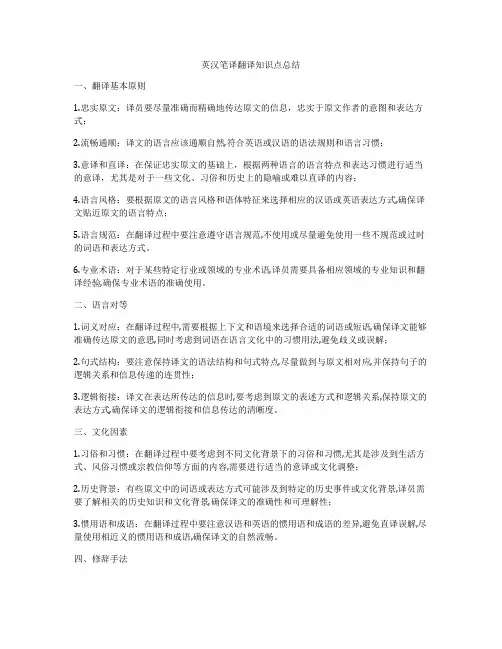
英汉笔译翻译知识点总结一、翻译基本原则1.忠实原文:译员要尽量准确而精确地传达原文的信息,忠实于原文作者的意图和表达方式;2.流畅通顺:译文的语言应该通顺自然,符合英语或汉语的语法规则和语言习惯;3.意译和直译:在保证忠实原文的基础上,根据两种语言的语言特点和表达习惯进行适当的意译,尤其是对于一些文化、习俗和历史上的隐喻或难以直译的内容;4.语言风格:要根据原文的语言风格和语体特征来选择相应的汉语或英语表达方式,确保译文贴近原文的语言特点;5.语言规范:在翻译过程中要注意遵守语言规范,不使用或尽量避免使用一些不规范或过时的词语和表达方式。
6.专业术语:对于某些特定行业或领域的专业术语,译员需要具备相应领域的专业知识和翻译经验,确保专业术语的准确使用。
二、语言对等1.词义对应:在翻译过程中,需要根据上下文和语境来选择合适的词语或短语,确保译文能够准确传达原文的意思,同时考虑到词语在语言文化中的习惯用法,避免歧义或误解;2.句式结构:要注意保持译文的语法结构和句式特点,尽量做到与原文相对应,并保持句子的逻辑关系和信息传递的连贯性;3.逻辑衔接:译文在表达所传达的信息时,要考虑到原文的表述方式和逻辑关系,保持原文的表达方式,确保译文的逻辑衔接和信息传达的清晰度。
三、文化因素1.习俗和习惯:在翻译过程中要考虑到不同文化背景下的习俗和习惯,尤其是涉及到生活方式、风俗习惯或宗教信仰等方面的内容,需要进行适当的意译或文化调整;2.历史背景:有些原文中的词语或表达方式可能涉及到特定的历史事件或文化背景,译员需要了解相关的历史知识和文化背景,确保译文的准确性和可理解性;3.惯用语和成语:在翻译过程中要注意汉语和英语的惯用语和成语的差异,避免直译误解,尽量使用相近义的惯用语和成语,确保译文的自然流畅。
四、修辞手法1.隐喻和比喻:在翻译中,对于原文中的隐喻和比喻,译员需要根据上下文和语境进行合适的意译,确保译文能够传达原文作者的表达意图和情感色彩;2.排比和对仗:在翻译文学作品时,需要注意原文中的排比和对仗等修辞手法,选择相应的汉语或英语表达方式,保持原文的格调和艺术效果;3.修辞疑问:译员需要充分理解原文的修辞手法和表达方式,并在译文中保留相应的修辞特色,确保译文的艺术性和表现力。
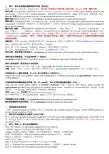
1.例子:现在必须采取措施来保护环境(表目的)分析:找主语->无主语,也就是无主句。
无主语:对应英文三种句型:形式主语、there be 句型、被动句型。
形式主语:It is necessary ['nesəs(ə)rɪ] /essential [ɪ'senʃ(ə)l] / imperative /ɪm'perətɪv/to take/ adopt measures to protect the environment.(不定式表目的)essential, imperative。
能用高级词汇就用高级词汇。
adopt: 有两个意思,采取采纳;收养;there be 句型There is necessity [nə'sɛsəti] to adopt measures to protect the environment.被动句型(找被动句型的主语-:措施)Measures should be adopted (taken) to protect the environment.特殊句型:是到做某事的时候了It is time to do sth.... 是到做某事的时候了It is high time to adopt measures to protect the environment.(更加地道)。
使用从句,从句使用虚拟语气,动词用一般过去时It is high time that measures were adopted to protect the environment确定句型、结构1)确定基准时态,能够避免犯大的语法错误比如:记叙文――一般过去时,以及他的变化议论文、说明文――一般现在时。
对照原文,首先检查译文是否正确的转述了原文的内容,是否有错译和漏译;其次,检查是否有语言上的明显错误,如:时态、语态、单复数、拼写、大小写、标点符号等,发现错误,及时改正。
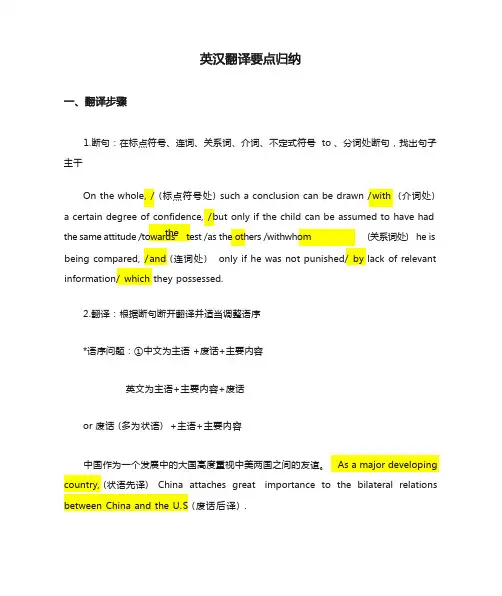
1.断句:在标点符号、连词、关系词、介词、不定式符号 to 、分词处断句,找出句子 主干On the whole, / (标点符号处) such a conclusion can be drawn /with (介词处)a certain degree of confidence, /but only if the child can be assumed to have hadbeing compared, /and (连词处) only if he was not punished/ by lack of relevant information/ which they possessed.2.翻译:根据断句断开翻译并适当调整语序*语序问题:①中文为主语 +废话+主要内容英文为主语+主要内容+废话or 废话 (多为状语) +主语+主要内容中国作为一个发展中的大国高度重视中美两国之间的友谊。
As a major developing country, (状语先译) China attaches great importance to the bilateral relations between China and the U.S (废话后译) .the the same attitude /towards test /as the others /withwhom (关系词处) he isvery ②总分关系:中文先分后总,英文先总后分③事实与评论:中文先事实后评论,英文先评论后事实我们要努力学习英语,这是很重要的。
It is important (先评论) for us tomakeefforts to study English.●比较级属于评论性词,最后译3.重读:看是否符合中文习惯1.谓语动词过渡:只译主要动词(强势动词,有感情色彩),不译次要动词 (弱势动词, 无感情色彩)I give you my support. 我支持你( give 弱势动词,不用翻译)2.抽象名词译法:【抽象名词: the+n. +of 结构中名次通常为抽象名词,且常以 “ -tion,-sion,-ment,-ing ”形式出现】译法: A.有动词词根:译为动词The suggestion of mine is that 我建议……B.无动词词根:进行增词the spirit of our nation 我们民族所具有的精神C.AB 互换( “偏正互换”译法)在英译汉中偏正→正偏treasury of silt 宝贵的泥沙European ’s today 当今的欧洲人1.长短差异:中文善用短句,用标点隔开;英文善用长句,不用标点→在进行英译汉时要进行断句翻译2.动静差异:中文是动态性语言,善用动词副词,善用强势动词;英文是静态性语言,善用名词,善用弱势动词→在汉译英中常把 ad.转化为 v.,把 v.转化为 n.在经济上,我们要加快(副词)建立(动词)社会主义市场经济体制。


十二天突破英汉翻译笔记一总述1英译汉翻译步骤断句,翻译,重读译文3中英文的三大差异1)中文善于用短句,且用逗号隔开英文善于用长句,不用标点2)中文善于用动词,属于动态性语言英文善于用名词,属于静态性语言3)中文是意合语言,所以句与句之间的连词比较少英文是形合语言,所以句与句之间的连词较多4英汉互译中的四大规律1)动词的过渡英译汉强势动词代替弱势动词两大要求:一个句子出现有主次关系的两个动词主要动词已经发变体且直译不通顺时,只翻译强势动词汉译英弱势动词代替强势动词2)抽象名词的翻译若有动词词根,译为动词若无动词词根,增加一个动词3)增词与减词英译汉四种增词方法增评论性词(出现在文学作品中)增对象词和范围词增范畴词增动词自然增词法(宾语前缺少动词)人为增词法(抽象名词的增词)4)汉译英时谓语动词的层次性根据词与词,句与句之间的逻辑关系,判断动词的重要性最主要的动词作为核心谓语次要的动词作为非谓语动词或从句再次的动词作为介词最不重要的动词不翻译5汉译英换主语1)主语是偏正短语时,将“偏”做主语2)在中文里找到隐藏主语3)无主语句子用被动语态就近原则6汉译英四字短语的翻译AABB=ABABAB=ABABCD=解释二定语从句的翻译1定语的位置中文:被修饰词之前英文:1)词修饰另一个词:大部分前置abeautifulcity形容词修饰不定代词时后置somethingimportantAlive,asleep,alike等作定语时后置acatalive过去分词作定语时可以后置achildadopted2)句子修饰一个词:全部后置2定语从句译成汉语后的位置:八前九后3非限定性英语从句后置译法需要译出关系词4定语从句的循环套用:后置译法中心词+定1+定2+定3+...(定1修饰中心词定2修饰定1...)根据定语长度把定1和定2放在一起翻译或者把定2和定3放在一起翻译5只有两个定语的循环套用:句首译法先翻译定2,再翻译定1,最后翻译含有中心词的句子6定语从句的并列套用:后置译法,且关系词至只翻译一次7定语从句翻译技巧:用好“即”、“这”、“而”和破折号中心词+定1+定2+定3+...(定语都修饰中心词)三非谓语动词的翻译1若非谓语动词位于一个句子的最前面,就找主语若非谓语动词位于一个名词的后面,就按照定语从句的方法翻译2主谓偏正(adj的n)结构句子翻译不通时可以互相转换3分词的独立结构(有分词,有名词或代词)当做主谓结构翻译四被动语态的翻译1被动语态的四中翻译方法1)被动变主动(没有bysb施动者时可以用)2)找替代词受到遭到为…所是由…来v(是由鸟类来运输)让…给3)科技文献中用“可以”4)有被不用被六代词的翻译1)代词指明要点12)不抽象不具体代词的间隔翻译法:多个代词同时指代同一个东西,奇数译为代词偶数译为具体七形容词和副词的翻译1用其延伸含义2形容词副词互相转换3长的形容词和副词翻译成一个短句7其它翻译技巧总结1not...because(表示原因的词例如by)...引导的是从句时,不否定转移引导的是短语时,要否定转移2英译汉时,英文中的介词翻译成动词或方位词3主语与废话的关系中文:主语+废话+主句英文:废话+主语+主句主语+主句+废话4suggestthat./assumethat.引导观点时翻译成认为5some可以翻译成“某些”6事实与评论的关系中文:先事实后评论(比较级也属于评论)英文:先评论后事实7插入语表示观点时需要提到句首翻译,例如Itisoftensaidthat.人们常说.8分词位于句首时,先找主语再进行翻译9中文:时间+地点英文:地点+时间英译汉方式在句首时,先翻译方式方式时间地点都在后面时,方式放在中间翻译10when可以翻译为在….时drive可以翻译成“让”11时间位于句首时,译为状语12同位语从句译为主谓结构或者顶针(重译法)13主句过长单独成句14同指现象只翻译一次15中文中的关联词双双出现2。
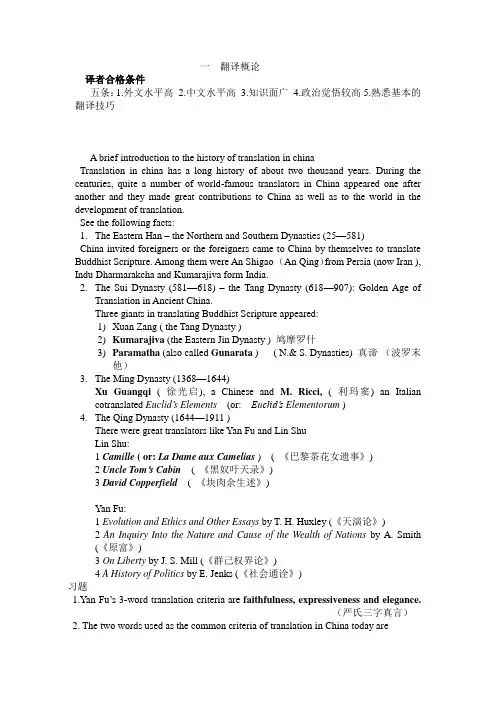
一翻译概论译者合格条件五条:1.外文水平高2.中文水平高3.知识面广4.政治觉悟较高5.熟悉基本的翻译技巧A brief introduction to the history of translation in chinaTranslation in china has a long history of about two thousand years. During the centuries, quite a number of world-famous translators in China appeared one after another and they made great contributions to China as well as to the world in the development of translation.See the following facts:1.The Eastern Han – the Northern and Southern Dynasties (25—581)China invited foreigners or the foreigners came to China by themselves to translate Buddhist Scripture. Among them were An Shigao (An Qing)from Persia (now Iran ), Indu Dharmarakcha and Kumarajiva form India.2.The Sui Dynasty (581—618) –the Tang Dynasty (618—907): Golden Age ofTranslation in Ancient China.Three giants in translating Buddhist Scripture appeared:1)Xuan Zang ( the Tang Dynasty )2)Kumarajiva (the Eastern Jin Dynasty ) 鸠摩罗什3)Paramatha (also called Gunarata ) ( N.& S. Dynasties) 真谛(波罗末他)3.The Ming Dynasty (1368—1644)Xu Guangqi ( 徐光启), a Chinese and M. Ricci,( 利玛窦) an Italian cotranslated Euclid’s Elements (or: Euclid’s Elementorum )4.The Qing Dynasty (1644—1911 )There were great translators like Yan Fu and Lin ShuLin Shu:1Camille ( or: La Dame aux Camelias) ( 《巴黎茶花女遗事》)2 Uncle Tom’s Cabin( 《黑奴吁天录》)3 David Copperfield( 《块肉余生述》)Yan Fu:1 Evolution and Ethics and Other Essays by T. H. Huxley (《天演论》)2 An Inquiry Into the Nature and Cause of the Wealth of Nations by A. Smith(《原富》)3 On Liberty by J. S. Mill (《群己权界论》)4 A History of Politics by E. Jenks (《社会通诠》)习题1.Yan Fu’s 3-word translation criteria are faithfulness, expressiveness and elegance.(严氏三字真言)2. The two words used as the common criteria of translation in China today arefaithfulness and smoothness.3. Translation is a representation or recreation in one language of what is written orsaid in another language, not only an art but also a science. (what is meant by translation?)4. Karl Marx was fond of saying: “A foreign language is a weapon in the struggle oflife.”5. Generally speaking, a qualified translator should have five prerequisites:1 a good command of the source language,2 a good command of the target language,3 a wide range and scope of knowledge,4 a high political consciousness,5 a necessary knowledge of basic techniques used in translation.6. To me, the criteria of translation should be the following two words: faithfulnessand smoothness, or even only one word:faithfulness. (what do you think should be the criteria of translation?) (faithfulness 更重要)“宁顺而不信。
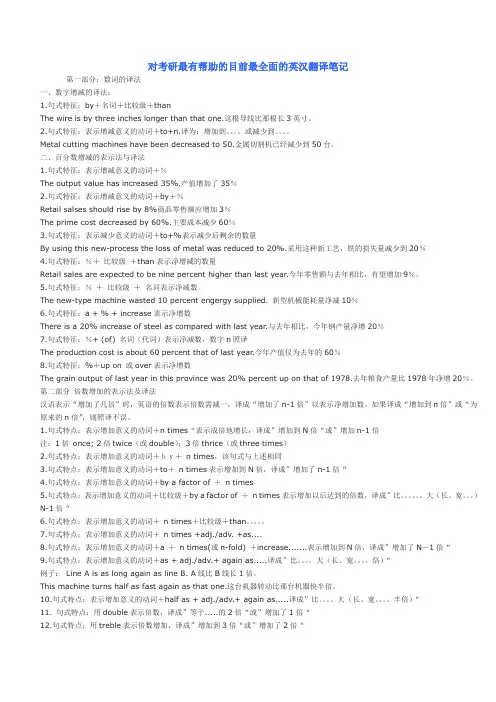
对考研最有帮助的目前最全面的英汉翻译笔记第一部分:数词的译法一、数字增减的译法:1.句式特征:by+名词+比较级+thanThe wire is by three inches longer than that one.这根导线比那根长3英寸。
2.句式特征:表示增减意义的动词+to+n.译为:增加到。
或减少到。
Metal cutting machines have been decreased to 50.金属切割机已经减少到50台。
二、百分数增减的表示法与译法1.句式特征:表示增减意义的动词+%The output value has increased 35%.产值增加了35%2.句式特征:表示增减意义的动词+by+%Retail salses should rise by 8%商品零售额应增加3%The prime cost decreased by 60%.主要成本减少60%3.句式特征:表示减少意义的动词+to+%表示减少后剩余的数量By using this new-process the loss of metal was reduced to 20%.采用这种新工艺,铁的损失量减少到20%4.句式特征:%+比较级+than表示净增减的数量Retail sales are expected to be nine percent higher than last year.今年零售额与去年相比,有望增加9%。
5.句式特征:%+比较级+名词表示净减数The new-type machine wasted 10 percent engergy supplied. 新型机械能耗量净减10%6.句式特征:a + % + increase表示净增数There is a 20% increase of steel as compared with last year.与去年相比,今年钢产量净增20%7.句式特征:%+ (of) 名词(代词)表示净减数,数字n照译The production cost is about 60 percent that of last year.今年产值仅为去年的60%8.句式特征:%+up on 或over表示净增数The grain output of last year in this province was 20% percent up on that of 1978.去年粮食产量比1978年净增20%。
第一部分:数词的译法一、数字增减的译法:1.句式特征:by+名词+比较级+thanThe wire is by three inches longer than that one.这根导线比那根长3英寸。
2.句式特征:表示增减意义的动词+to+n.译为:增加到。
或减少到。
Metal cutting machines have been decreased to 50.金属切割机已经减少到50台。
二、百分数增减的表示法与译法1.句式特征:表示增减意义的动词+%The output value has increased 35%.产值增加了35%2.句式特征:表示增减意义的动词+by+%Retail salses should rise by 8%商品零售额应增加3%The prime cost decreased by 60%.主要成本减少60%3.句式特征:表示减少意义的动词+to+%表示减少后剩余的数量By using this new-process the loss of metal was reduced to 20%.采用这种新工艺,铁的损失量减少到20%4.句式特征:%+比较级+than表示净增减的数量Retail sales are expected to be nine percent higher than last year.今年零售额与去年相比,有望增加9%。
5.句式特征:%+比较级+名词表示净减数The new-type machine wasted 10 percent engergy supplied. 新型机械能耗量净减10%6.句式特征:a + % + increase表示净增数There is a 20% increase of steel as compared with last year.与去年相比,今年钢产量净增20%7.句式特征:%+ (of) 名词(代词)表示净减数,数字n照译The production cost is about 60 percent that of last year.今年产值仅为去年的60%8.句式特征:%+up on 或over表示净增数The grain output of last year in this province was 20% percent up on that of 1978.去年粮食产量比1978年净增20%。
B. 套话、惯用语或文言句式的转换:翻译时一般应遵循译入语的习惯,尽量找到对应的惯用表达。
(汉语多用四字结构)汉译英时可套用英语的程式化的、特别正式的词语,以保译文和原文意义和风格的一致。
●(15) Thank you for your kind consideration.●承蒙垂注,谨致谢意。
●(16) The extreme shortage of recent goods made us feel regretful being unable to offer theprice.●货源奇紧,歉难报盘。
(17)本人冒昧地邀请贵方光临我方展台,购买与否,悉听尊便。
●I venture to invite you to have a look at our stand, and you may rest assured that you willnot be pressed to buy.●(18)兹通知,海尔公司将采取一切必要的措施,追究任何未经许可制造或销售注有海尔商标的当事人。
●Notice is hereby given that HAIER Co., Ltd. Will take all necessary measures against anyparty manufacturing and/or selling any products bearing the trade mark of "HAIER"without being authorized.●(19)甲方同意向乙方支付以下称为特许权使用的费用,该费用等于售货总额的5%。
●Party A agrees to pay to Party B an amount hereinafter called royalty equal to 5% of thegross sales.●(20)岳阳渔业公司(下称甲方)和厦门海产有限公司(下称已方)通过友好协商与谈判达成如下协议。
英汉笔译课笔记(应该未全)英汉笔译课笔记(应该未全)据说英汉笔译考试内容都在我们平时的作业上出(上届师兄说的),大家多注意一下吧。
一下是我平时的笔记还有舍友的笔记整理,希望能帮到大家。
(PS:我也发到群邮箱了)A 用词不同Black tea 红茶White coffee/ black coffee 加牛奶/不加牛奶的咖啡a black ship 被罢工工人抵制装卸的船black studies (美国大学中)研究黑人问题的学科black sheep 败家子black widow 黑寡妇black smith 铁匠black bird 画眉black birding (殖民主义的)贩奴活动in the black 盈利in the red 赤字,亏损black and blue 遍体鳞伤look black (前景)暗淡laugh off one’s head 笑掉大牙sister states 兄弟省市green-eyed 嫉妒pink eye 患红眼病stop thief 抓贼啊white sale 床上用品大减价an off season 淡季ID card 身份证B 词的搭配不同make money 挣钱wet snow 雨夹雪Although the morning was young 天气尚早C 语言结构不同No comments 无可奉告We need talking heads.招收电话员启示good team work 配合默契This is VOA, signing on.美国之音,现在开始播音。
He is swimming is money. 他腰缠万贯。
under the rose 秘密地一词多义翻译1. like charger repel, unlike charges attract. 同性相斥,异性相吸。
2. like knows like. 英雄识英雄。
3. like begets like, like father, like son.龙生龙,凤生凤,老鼠的儿子能打洞。
考研英汉翻译笔记:分词短语1/现在分词短语:现在分词短语必须放在所修饰名词的后面,它相当于一个包含一般时或进展时谓语的从句(完成分词不能这样用):It is a question puzzling many people.He was a businessman growing rich in recent years.(比拟:He is a growing boy.)The gentleman talking so loudly is my uncle.(比拟:Can you read her talking eyes?)The lady visiting us from time to time taught us French. will be vicious. by her husband called on me one day. (带有副词短语)I drink water boiled at least ten minutes.Book called the comics may be harmful to children. when they are yong will become good citizens. by so many students.The text-book being used in this school is Let Us Learn French.c)前面带as的分词连词as可以用在分词前面The news as arriving .The results as proclaimed in today's newspaper are encouraging.His ability as displayed during the last three months was inadequate.I will tell you a story as told by my mother.b.作主语补语的分词现在分词和过去分词都可以用在is,was,grow,feel这类系动词后做补语(亦称表语)。
《十二天突破英汉翻译:笔译篇》笔记总结一、中英三大差异:中文:英文:短句,多标点长句,少标点动态(强势动词)静态(弱势动词、名词)意合(“竹竿”型)形合(“葡萄”型,连词)二、四大规律:①谓语动词的过渡:a. 英译中时,主次关系动词翻译过来不通顺,应该把主要动词翻译成强势动词,而次要动词过渡为弱势动词一般省略。
b. 中译英时,用弱势动词过渡到强势动词。
例:我支持你。
不应该翻译(笔译)为”I support you.” 而是”I give you my support.”②抽象名词的译法:有动词词根就译为动词,没有就增动词。
③增词与减词:主要原则“英译汉增词,汉译英减词” a.增减评论性词(在文学翻译中常见);b.增减范围词和对象词;c. 增减范畴词(方式、方法、水平、问题、途径等等);d.增减动词:第一,自然增词法:在宾语前缺少动词时,我们就按照中文的习惯进行增词。
例:He wears a coat, a hat and a scarf. 他穿着一件上衣,戴着一顶帽子,系着一个围脖。
第二,人为增词法:是由抽象名词造成的增词。
例:The samples of soil from various depths are examined for traces of oil. 从不同的深度采集出土壤样本,然后进行检测,看看有没有油。
④中译英时谓语动词的层次性:因为中文是动态性语言,所以句子中的动词较多,而英文是静态性语言,名词、非谓语动词、从句和介词较多,所以英文的一个句子只有一个谓语,而不是多个动词构成的谓语。
由此看来,我们要在纷繁复杂的动词中判断出哪个动词更重要,哪个动词重要和哪个动词不重要。
一般来说,先发生的动词更加重要,而后发生的动作不是那么重要。
因此根据动词的重要性先后顺序,可以依次译为核心谓语动词、非谓语动词、介词、不译。
三、两个步骤:①中译英:断句、翻译、重读②英译中:找谓语、找连词、翻译、重读四、一个原则:当翻译时句子不通顺,应该采取重新断句,再不行就要考虑偏正短语的主谓译法或者主谓的偏正译法。
英汉翻译笔记整理一、数字增减的译法:1.句式特征:by+名词+比较级+thanThe wire is by three inches longer than that one.这根导线比那根长3英寸。
2.句式特征:表示增减意义的动词+to+ n.译为:增加到。
或减少到。
Metal cutting machines have been decreased to 50.金属切割机已经减少到50台。
二、百分数增减的表示法与译法1.句式特征:表示增减意义的动词+%The output value has increased 35%.产值增加了35%2.句式特征:表示增减意义的动词+by+%Retail sales should rise by 8%商品零售额应增加3%The prime cost decreased by 60%.主要成本减少60%3.句式特征:表示减少意义的动词+to+%表示减少后剩余的数量By using this new-process the loss of metal was reduced to 20%.采用这种新工艺,铁的损失量减少到20%4.句式特征:%+比较级+than表示净增减的数量Retail sales are expected to be nine percent higher than last year.今年零售额与去年相比,有望增加9%。
5.句式特征:%+比较级+名词表示净减数The new-type machine wasted 10 percent energy supplied. 新型机械能耗量净减10%6.句式特征:a + % + increase表示净增数There is a 20% increase of steel as compared with last year.与去年相比,今年钢产量净增20%7.句式特征:%+ (of) 名词(代词)表示净减数,数字n照译The production cost is about 60 percent that of last year.今年产值仅为去年的60%8.句式特征:%+up on 或over表示净增数The grain output of last year in this province was 20% percent up on that of 1978.去年粮食产量比1978年净增20%。
汉语表示“增加了几倍”时,英语的倍数表示倍数需减一,译成“增加了n-1倍”以表示净增加数。
如果译成“增加到n倍”或“为原来的n倍”,则照译不误。
1.句式特点:表示增加意义的动词+n times“表示成倍地增长,译成”增加到N倍“或”增加n-1倍“注:1倍 once; 2倍twice(或double);3倍thrice(或three times)2.句式特点:表示增加意义的动词+by+ n times,该句式与上述相同3.句式特点:表示增加意义的动词+to+ n times表示增加到N倍,译成”增加了n-1倍4.句式特点:表示增加意义的动词+by a factor of + n times5.句式特点:表示增加意义的动词+比较级+by a factor of + n times表示增加以后达到的倍数,译成”比。
大(长、宽。
)N-1倍“6.句式特点:表示增加意义的动词+ n times+比较级+than。
7.句式特点:表示增加意义的动词+ n times +adj./adv. +as....8.句式特点:表示增加意义的动词+a + n times(或n-fold) +increase.......表示增加到N倍,译成”增加了N-1倍“9.句式特点:表示增加意义的动词+as + adj./adv.+ again as.....译成”比。
大(长、宽。
倍)“例子: Line A is as long again as line B. A线比B线长1倍。
This machine turns half as fast again as that one.这台机器转动比那台机器快半倍。
10.句式特点:表示增加意义的动词+half as + adj./adv.+ again as.....译成”比。
大(长、宽。
半倍)“11. 句式特点:用double表示倍数,译成”等于.....的2倍“或”增加了1倍“12.句式特点:用treble表示倍数增加,译成”增加到3倍“或”增加了2倍“13.句式特点:用quadruple表示倍数增加,译成”增加到4倍“或”增加了3倍“倍数减少在英译时,需把倍数换算成分数。
成几倍减少,可以改译成”减少到1/N“或减少了”N-1/N“。
而减少了N倍,可改译成”减少到1/N+1“或”减少了N/N+1“。
1.句式特点:表示减少意义的动词+N times表示成N倍减少,译成”减少到1/N“或”减少了N-1/N“The length of laser tube was reduced ten times.激光管的长度缩短了十分之九。
2.句式特点:表示减少意义的动词+by+N times表示成N倍减少,译成”减少到1/N“或”减少了N-1/N“The band with was reduced by two times.带宽减少了二分之一。
3.句式特点:表示减少意义的动词+by a factor of + N times表示成N倍减少,译成”减少到1/N“或”减少了N-1/N“4.句式特点:表示减少意义的动词+a-N times(N-fold)+ reduction 译成”减少到1/N“或”减少了N-1/N“The principal advantage over the old-fashioned machine is a four-fold reduction in weight.与旧式机器比,主要特点是重量减少了四分之三。
5.句式特点:表示减少意义的动词+N times+as + adj./adv. .....译成”减少到1/N“或”减少了N-1/N“6.句式特点:表示减少意义的动词+N times+ 比较级+ than表示减少了N倍,译成”减少到1/N+1”或“减少了1/N+1“The plastic container is five times lighter than that glass one.这个塑料容器比那个玻璃容器轻六分之五。
英语倍数句型及其译法英语表示倍数增减或倍数对比的句型多种多样,其中有一些(如下文中的句型②、⑤、⑥、⑧、(12)等,见圈码)很容易译错——其主要原因在于:英汉两语在表述或对比倍数方面存在着语言与思维差异。
现将常用的英语倍数句型及其正确译法归纳如下:倍数增加(一) A is n times as great(long,much,…)as B.(①)A is n times greater (longer, more,…)than B.(②)A is n times the size (length, amount,…)of B.(③)以上三句都应译为;A的大小(长度,数量,……)是B的n倍[或A比B大(长,多,……)n-1倍].Eg. This book is three times as long as (three times longer than,threetimes the length of )that one.这本书的篇幅是那本书的3倍(即长两倍)。
注:当相比的对象B很明显时,than(as,of)B常被省去。
(二)increase to n times(④)increase n times/n-fold(⑤)increase by n times(⑥)increase by a factor of n(⑦)以上四式均应译为:增加到n倍(或:增加n-1倍)。
Eg. The production of integrated circuits has been increased to three timesas compared with last year.集成电路的产量比去年增加了两倍。
Eg. The output of chemical fertilizer has been raised five times as againstl986.化肥产量比1986年增加了4倍。
Eg. That can increase metabolic rates by two or three times. 那可使代谢率提高到原来的2倍或3倍(即提高1倍或2倍)。
Eg. The drain voltage has been increased by a factor of four. 漏电压增加了3借(即增加到原来的4倍)。
注:在这类句型中increase常被raise,grow,go/step up,multiply 等词所替代。
(三)There is a n-fold increase/growth…(⑧)应译为:增加n-倍(或增至n倍)。
这个句型还有其它一些形式:Eg. A record high increase in value of four times was reported. 据报道,价值破记录地增长了3倍。
(四)double (增加1倍),treble(增加2倍),quadruple(增加3倍)。
(⑨)Eg. The efficiency of the machines has been more than trebled or quadrupled.这些机器的效率已提高了2倍或3倍多。
(五)此外,英语中还有一种用again而不用倍数词来比较倍数的方法,如:A is as much (large,long,…)again as B.(= A is twice as much (large,long,…)asB.(⑩)应译为:A比B多(大,长,……)1倍。
A is half as much (large, 1ong,…)again as B.【= A is one and a half times as much (large, 1ong,…)as B.】(11)应译为:A比B多(大,长……)一半(即A是B的一倍半)。
倍数减少(一)A is n times as small (light,slow,…)as B.(12) A is n times smaller (lighter, slower,…) than B.(13)以上两句均应译为:A的大小(重量,速度,……)是B的1/n[或A 比B小(轻,慢,……)(n-1)/n]。